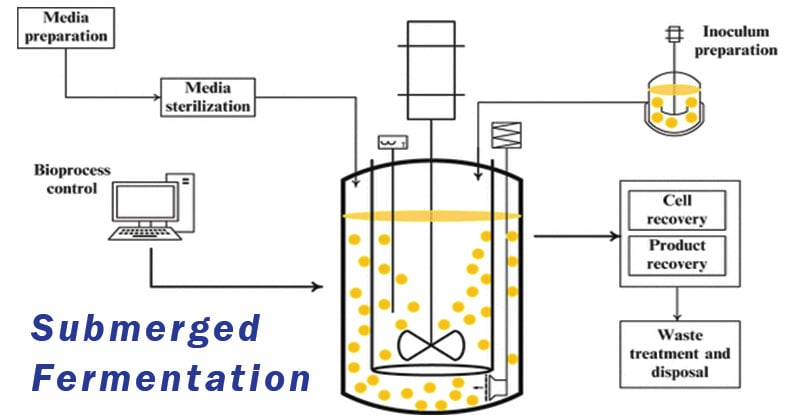- Fermentation is the technique of biological conversion of complex substrates into simple compounds by various microorganisms such as bacteria and fungi.
- In the course of this metabolic breakdown, they also release several additional compounds apart from the usual products of fermentation, such as carbon dioxide and alcohol. These additional compounds are called secondary metabolites.
- Secondary metabolites range from several antibiotics to peptides, enzymes and growth factors.
- The development of techniques such as Solid State Fermentation (SSF) and Submerged Fermentation (SmF) has lead to industrial-level production of bioactive compounds.

Submerged fermentation
- Submerged fermentation is a method of manufacturing biomolecules in which enzymes and other reactive compounds are submerged in a liquid such as alcohol, oil or a nutrient broth.
- Submerged Fermentation (SmF)/Liquid Fermentation (LF) SmF utilizes free-flowing liquid substrates, such as molasses and broths.
- The process is used for a variety of purposes, mostly in industrial manufacturing.
Principle of Submerged Fermentation
Submerged fermentation involves the growth of the microorganism as a suspension in a liquid medium in which various nutrients are either dissolved or suspended as particulate solids in many commercial media.
- Submerged fermentation is a process involving the development of microorganisms in a liquid broth.
- This liquid broth contains nutrients and it results in the production of industrial enzymes, antibiotics or other products.
- The process involves taking a specific microorganism such as fungi and placing it in a small closed flask containing the rich nutrient broth.
- A high volume of oxygen is also required for the process. The production of enzymes then occurs when the microorganisms interact with the nutrients on the broth resulting in them being broken down.
- The bioactive compounds are secreted into the fermentation broth.
Methods of Carrying Out Submerged Fermentation
There are two common methods by which submerged fermentation takes place; they are batch-fed fermentation and continuous fermentation.
- In batch-fed fermentation sterilized growth nutrients are added to the culture. It is most common in bio-industries as it occurs during the growth of biomass in the fermenter. It helps raise the cell density in the bioreactor and it is typically highly concentrated to stop dilution. The rate of growth in the culture is maintained by adding nutrients, this also reduces the risk of overflow metabolism.
- An open system is constructed for continuous fermentation. Then sterilized liquid nutrients are slowly and continuously added to the bioreactor at the same rate at which the converted nutrient solution is being recovered from the system. This results in a steady-rate production of the fermentation broth.
In order to maintain a successful fermentation, certain variables must be monitored, for example, temperature, pH, as well as oxygen and carbon dioxide levels.
Submerged Fermentation Substrate
Some common substrates used in submerged fermentation are soluble sugars, molasses, liquid media, fruit and vegetable juices, and sewage/wastewater.
Applications of Submerged Fermentation
- SmF is primarily used in the extraction of secondary metabolites that need to be used in liquid form.
- Submerged liquid fermentations are traditionally used for the production of microbially derived enzymes.
Advantages of Submerged Fermentation
- Submerged fermentation technology has the advantages of short period, low cost and high yield.
- Purification of products is easier.
- In liquid culture the control of the fermentation is simpler and consequently significant reductions in fermentation times can be achieved.
- In the same way, the use of submerged culture can benefit the production of many secondary metabolites and decrease production costs by reducing the labour involved in solid-state methods.
Limitations of Submerged Fermentation
- In recent years, many researchers have demonstrated that SSF has a large impact on productivity, leading to higher yields and improved product characteristics compared to SmF
- Low volumetric productivity
- Relatively lower concentration of the products
- More effluent generation
- Complex fermentation equipments
References
- https://www.sciencedirect.com/topics/agricultural-and-biological-sciences/submerged-fermentation
- https://www.ukessays.com/essays/biology/submerged-and-solid-state-fermentation-biology-essay.php
- https://www.researchgate.net/
- http://www.davidmoore.org.uk/21st_Century_Guidebook_to_Fungi_PLATINUM/Ch17_12.htm
- https://www.slideshare.net/DeepakBajantri/fermentation-technology-59569219
- https://www.omicsonline.org/scholarly/submerged-fermentation–journals-articles-ppts-list.php
- http://agris.fao.org/agris-search/search.do?recordID=CN2006001496
- https://link.springer.com/article/10.1023/A:1023609427750
- http://europepmc.org/abstract/cba/602507
- https://www.sciencedirect.com/topics/nursing-and-health-professions/submerged-fermentation
- http://www.answers.com/Q/What_are_the_disadvantages_of_submerged_fermentation
- https://www.science.gov/topicpages/l/liquid+state+fermentation
- http://ecoursesonline.iasri.res.in/mod/page/view.php?id=5150
- https://www.revolvy.com/page/Industrial-microbiology

hey fermentation is an anaerobic process ,you have mentioned it requires oxygen
Hello Tulsi,
Fermentation can occur both in the absence and presence of both. In the presence of oxygen, it is called aerobic fermentation.
okay but classical definition mentions its anerobic ,can please provide the source that say it.